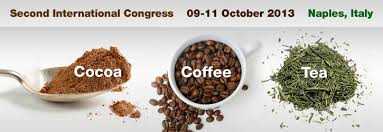Share your coffee stories with us by writing to info@comunicaffe.com.
MILAN – We begin today the publication of around 100 lectures and posters given at the Second International Congress on Cocoa, Coffee and Tea (CoCoTea2013), which took place in Naples on 9th-11th October 2013 at the Congress Centre of the University of Naples Federico II.
RECENT ADVANCES ON THE CHARACTERISATION OF BLACK TEA THEARUBIGINS Nikolai Kuhnert, Sujatha Jayaraman, Christian Grün and Ghada Yassin 1 Chemistry, School of Engineering and Science, Jacobs University Bremen, Germany. 2 Unilever Research and Development, Bangalore, India.
Black tea thearubigins (TRs) are formed by oxidative fermentation of green tea catechins. TRs account for around 70 % of the phenolics in a typical black tea infusion.
They are vying together with chlorogenic acids for the first spot in daily dietary polyphenol intake in a typical diet.
TRs were first described by E. A. H. Roberts more than 50 years ago and have posed an unsurmountable analytical challenge for more than five decades, remaining of a mysterious and enigmatic nature.1
Recently we have shown that the SII fraction of TRs contains around 30 000 individual compounds with a molecular weight below 2 000 Da formed from just six starting materials, turning black tea into the most complex dietary material ever analysed and into a true master of chemical diversity.
Using a combination of ultra high resolution and targeted tandem mass spectrometry we proposed a hypothesis that accounts for the mechanism of formation and structures present in TRs, which we named the “oxidative cascade hypothesis” (OCH).2,3
Within this contribution we summarise previous work and provide additional evidence for elements of the OCH, in particular evidence for the formation of B-ring linked trimeric and tetrameric catechin derivatives.
We show new data on mechanistic studies of TR formation giving a rationale on why black tea chemistry takes place at the catechin B-rings exclusively in contrast to most other plants using A-ring oxidation chemistry.
Additionally we show new data on fractions other than the SII fraction of TRs therefore providing a full picture of black tea composition.
<strong>References</strong> “On the chemistry of small molecular weight polyphenols in black tea” J. W. Drynan, M. N. Clifford, J. Obuchowicz and N. Kuhnert, Nat. Prod. Rep. 2010, 27, 417-462.
“On the chemical characterization of black tea thearubigins using mass spectrometry” N. Kuhnert, J. W. Drynan, J. Obuchowicz and M. Clifford, Rapid Commun. Mass Spetrom. 2010, 24, 3387-3404.
“Oxidative cascade reactions yielding polyhydroxy-theaflavins and theacitrins in the formation of black tea thearubigins: Evidence by tandem LC-MS” N. Kuhnert, M. N. Clifford and A. Müller, Food and Function, 2010, 1, 180-199.















